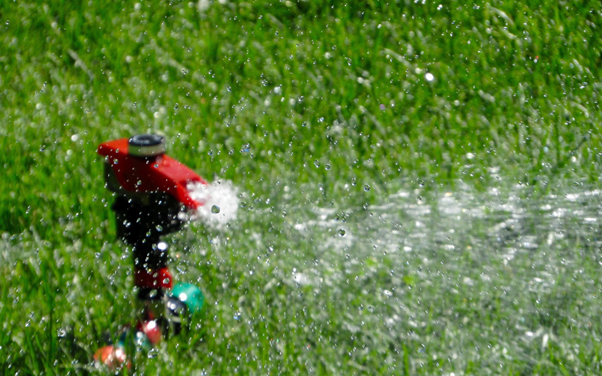How much water does your new turf need?
How much watering does my new turf need is a question we are asked most often by new turf owners or those looking to put down new turf. It is important not to let turf that has just been laid, dry out before its rooted down into the soil. Correct new turf watering gives it strong roots, consistent colour, and health, making it resilient, hardy, and drought tolerant. So how much watering does your new turf need? Here is our advice.

Watering new turf
New turf needs frequent watering. Water your turf daily for 2-4 weeks after laying it. In Summer and warmer weather the turf may require watering a few times per day until the roots are long enough to absorb sufficient water from the moist zone. Always ensure that the water filters through into the soil beneath your turf. Lift a corner and check the soil or push your finger into the root zone as this should be moist. Once the lawn starts becoming established and sets roots in the soil, you can decrease the watering frequency depending on the weather.
Why does new turf require constant watering?
The main reason why new turf requires watering is that grass is 85% water. It depends on water for its very existence. It should never be left to dry out.
During the harvesting process, your turf grass will lose a large portion of its roots system. Grass depends on the roots to draw food and water from the soil. As the root system gets re-established, it will be up to you to ensure it has all the water it needs within its reach.
When is the best time to water your new lawn?
Water your new turf as soon as it is laid. Since your main goal is to encourage the roots to sink deep into the soil, ensure the soil’s top 10cm is wet. If it’s a large lawn, it does need a sprinkler working on one section while you work on the next.

During the establishment period it is vital to water your lawn a few times a day, every single day for the first couple of weeks. Even if it rains, check if the soil beneath the turf is damp before adjusting the frequency of watering. On very hot days, increase the frequency of watering as needed.
The best practice is to water your lawn first thing in the morning or late in the evening. At these times, the air is cooler, and you are less likely to lose water due to evaporation.
In humid areas such as the South Eastern coastal areas of Queensland, the early morning is the best. Avoid late afternoon and early evening because there is an increased chance of fungal disease.
How much water does your new turf need?
Water is a vital element in your lawn care and maintenance program. The amount of water needed for your turf will vary according to various factors, including:
- Turf variety, drought tolerance, and water requirement as below:
| Turf Variety | Drought Resistance | Water Requirement |
| Golden Zoysia | Very High | Water-efficient. It requires water for the root system re-establishment. After that, it can usually do well on rainfall due to its deep-rooted system. |
| Golden Buffalo | Medium | In shady areas it does not use much more than other types. |
| ShadeTuff Zoysia | High | Grows well with minimal watering but responds to frequent watering. |
| Oakridge Kikuyu | High | Medium usually but can produce extra growth with extra water for high wear areas. |
| Wintergreen Couch | Very Good | It is drought tolerant and does well even when neglected. |
| Queensland Blue Couch |
Low | High due to shallow root system but will respond if neglected. |
| Grand Prix Couch | Very High |
Minimal once established and correctly maintained. Best root system for drought resistance. |
- The climate in your area and the season/weather.
- Soil type, and depth, and its ability to absorb and hold water.
- Conditions of your lawn, including its health, exposure to sun/wind. A lawn that is exposed to sun or wind will dry out faster and as such might need more watering.
All new turf needs sufficient water for root establishment. So frequent watering within the first few weeks is crucial.
How do I know if my lawn needs more watering?
If your turf is getting less water than it needs, you will notice that:
- It will start wilting or losing the vibrant colour. You may see the leaves turning yellow and then brown.
- The grass in the middle of the turf will start looking dry and patchy.
- If there is a noticeable footprint, then it probably needs to be watered. If you step on your lawn and it bounces back, it is well hydrated.
If you see any of these signs, then it is time to water, water, water! Water 2-3 times a day to re-wet the soil.
Final word
For the first watering session after laying turf, be very generous. It’s okay to have puddles sitting on top of the grass! For subsequent sessions, use your better judgment. As a rule of thumb, it’s better to have too much than too little water. You can find more tips on how to care for your lawn here on our website; Golden Finch Lawns.
